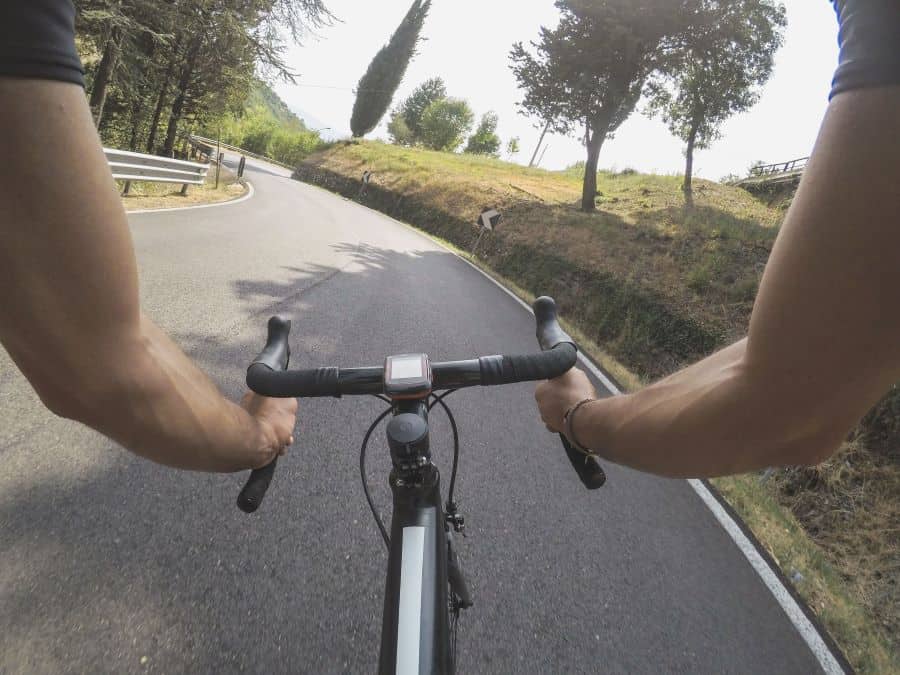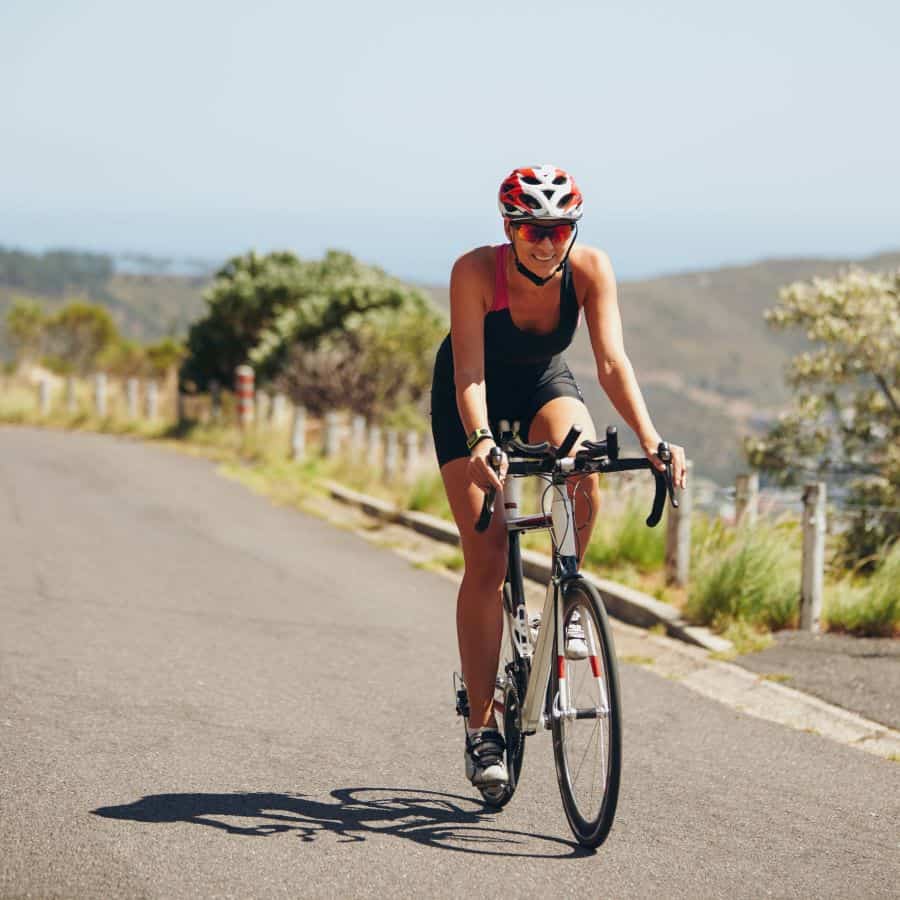This post may contain affiliate links. If you click an affiliate link and make a purchase, I may earn a commission. Also, as an Amazon Associate, I earn from qualifying purchases.--
Braking can make you or break you as a cyclist—quite literally at that.
The thing is, moving and braking safely on two wheels can be trickier, especially when it comes to going downhill. Many riders can share their stories of over-the-handlebar incidents caused by not braking correctly.
How to brake when cycling downhill? While cycling downhill, use the rear brake to slow down safely in conjunction with the front brake to come to a complete stop. Do not grab the brakes—especially the front brake—while cycling downhill or in corners because this can cause the bicycle to lock into place and you can crash.
This article will explore in-depth why braking downhill is so tricky and what you should know, expect, and look for during descends. So let’s take a look.

Which Brake to Use When Going Downhill?
Bicycles have front brakes and rear brakes. This sometimes can cause some confusion as to which brakes it is recommended to use.
Typically there are three main situations we can have:
- Using the front brake
- Using the rear brake
- Using both brakes at the same time
Using the front brake on the bicycle is always going to be more effective and provide better stopping power than using the rear brake alone. However, using both the front and the rear brakes provides the best stopping power.
Front brakes often provide up to 75% of the overall braking power. However, that percentage can rise even higher when going downhill. (Source)
Although both the front and the rear brakes can slow you down, it can be said that the front brake is used for more aggressive stopping while the rear for speed control.
Which brake and when to use it can vary depending on the type of riding you do, your experience, and more. For example, in on-road bikes, the front brake may be used less often. In comparison, experienced mountain bikers tend to use the front brakes a lot.
What Is the Correct Body Position While Braking on Descents?
While braking downhill assuming the right body position will allow you to stop more effectively and safely.
While moving downhill, the momentum shifts the rider’s weight to the front. If the rider is not in the correct body position and brakes too quickly, this can quickly cause their weight to move past the front tire and flip and fall.
Of course, braking downhill can be done by assuming the neutral body position that is used while riding flats. In that case, braking needs to be done gradually and very slowly in a more controlled manner.
When braking downhill, the rider should assume a body position with the center of gravity shifted further back. The rider can do this by straightening their arms and leaning to the back, moving their hips and thus the center of gravity behind the saddle. (Source)
However, don’t lock up your arms should not be at full extension, as this will leave you with no cushioning if you hit a bump or a pothole.
Putting your hands on the drop bars will offer a lower center of gravity and more stability.
Overall, the harder you brake, the more you will have to lean to the back.
How To Brake When Cycling Downhill
Practice Braking Downhill
It is vital to practice smooth braking while going downhill because simply grabbing on the brakes spells trouble.
To learn how to do it, you need to practice going downhills in order to get a feeling for how your bicycle moves and how much traction it has. Try to find your balance point while doing short and controlled braking downhill. Even small adjustments to the body position can cause dramatic changes to how effective the brakes are.
Never go past speeds that you feel comfortable with. And if you are approaching a corner, make sure to enter it with a speed that is way below the maximum for it. Keep in mind that the bike can accelerate very quickly through the corner, so it is recommended to stay on the safe side and not go too fast.
Ensure Your Center of Gravity and Weight Are Centered
Although it is recommended to use both brakes simultaneously, it is also important to understand how much pressure should be applied to them, which is connected to how the weight moves between the front and the rear.
You also don’t want to be too far back as this can put most of your weight on the rear tire, causing the front tire to lose traction.
Use the Rear Brake First
Applying slightly more pressure on the rear brake to prevent the weight from abruptly moving to the front all at once is recommended. As the weight slowly shifts to the rear, more pressure can be applied to the front brake to balance it out.
Don’t Grab the Brakes
If the front brake is grabbed very aggressively, the front wheel will lock, either causing skidding or immediately getting the rider to get up and over the handlebars and crash.
Skidding should be avoided. While rear-wheel skidding may not be a huge cause for concern losing traction on the front wheel can be particularly dangerous.
Ensure the Bicycle Is In Good Condition
It should also be mentioned that the bicycle should be in good condition, the brakes should be checked to ensure they work properly.

How to Brake When Cycling on Long Downhill Rides
Some riders may get worried about going on long stretches of road downhill because the bicycle can get too fast.
It is best to take some precautions and expect these long stretches of road.
On long downhill stretches of road, drag and feather the rear brake. However, ensure that the wheel does not lock up. If the rear brake is not enough to keep your speed down to a comfortable level, then start gradually applying the front brake.
Stay focused, and make sure to pay attention to what is ahead while keeping your distance from other vehicles and people. Keep in mind that it is possible for a small animal to dart quickly in front of you.
The road surfaces vary, and they affect the grip of the bicycle. This, in turn, will affect how quickly you can come to a stop. In dry conditions, the road will provide lots of grip. However, wet roads, debris, loose gravel, rocks, potholes will lower the tires’ grip.
How to Brake While Cornering and Cycling Downhill
Braking in corners is often avoided because it can be a recipe for trouble. It is always recommended to brake before you enter the corner.
Braking while cornering can cause the tires to lose traction. Tires have a limited amount of traction, and some is already being used while cornering.
On top of that, braking while cornering tends to cause the bike to stand up, and you may not be able to assume the correct body position because it will be harder for you to lean. This can throw off your trajectory and rhythm. There is also a big chance of the rear tire skidding.
Conversely, sometimes riders may need to use their brakes through corners—especially when it comes to downhill corners.
While riding downhill, the bike will tend to accelerate while you are in the corner if brakes are not used, which can cause the rider to lose control of the bicycle. This can be particularly dangerous if another corner follows shortly.
While some corners may not require you to modulate your speed through them, some will.
This calls for braking before the corner to slow down to a suitable speed which then transfers to a more controlled rear brake drag through the corner to keep the bike from accelerating too much. Often the rear brake is used very gently in these scenarios.
Even if things get out of hand and you will be crashing, applying the rear brake can help a little. It can cause the rear tires to skid, which is more manageable and will usually lead to a slide instead of a tumble—in any case, crashing, in general, should be avoided.
Although braking should not be used over time and with experience, riders can learn how to use it to their benefit; there will be the occasional corner that will require them to use some slight rear brake. And if used correctly, it can do more good than harm.
However, going downhill on roads that you are not familiar with can be problematic as you may not be able to judge your speed correctly. In these cases exercising extra care is recommended.
Overall it comes down to experience and making the right judgment calls at the right time. Things can be even trickier if you are riding during the night or on very technical tracks.
Resources:
- https://www.reddit.com/r/MTB/comments/byp2xc/braking_technique_how_do_you_use_them_front_or/
- https://bicycles.stackexchange.com/questions/36164/lessons-from-downhill-crash
- https://bicycles.stackexchange.com/questions/10918/do-skilled-cyclists-really-use-the-front-brake-alone-probably-95-of-the-time
- https://www.nytimes.com/2016/08/31/health/how-to-ride-downhill-on-a-bicycle.html
- https://www.youtube.com/watch?v=zp9p24-o3-Y
- https://www.reddit.com/r/cycling/comments/48hlow/too_fast_downhill/
